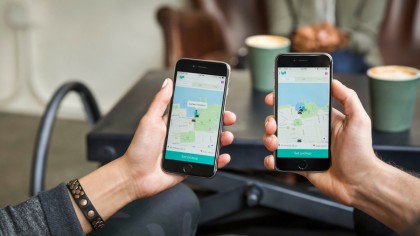Who are the digital disruptors redefining entire industries?
From Netflix to WhatsApp, digital disruptors are everywhere
Which industries are next for a digital makeover?
Are there any industries left standing that haven't yet had their world turned upside down by apps? Actually, yes there are. "Manufacturing that relies on 3D printers is perhaps still in the future, but certainly something that can have major repercussions for the construction industry," says Heinze, who also cites driverless cars as an incoming shake-up. Both are dependent on technology that has yet to be perfected, unlike the high street, which is now due a digital overhaul.

One hopeful start-up is Slyce, a visual search company specialising in image recognition in retail – you take a picture of the handbag/dress/hoody/jeans you want and it hunts online for the exact product. "The High Street is slow in embracing digital disruption," says Heinze. "Some stores are experimenting with 3D store versions and online sales, but with the way that online shopping is developing, chances are the future of the digital high street needs to be reconsidered."
However, it's the banking industry that is living on borrowed time. Core bank functions like lending, investing, payments and money transfer are under threat from apps. "All these services are already being offered by the likes of Lending Club, Funding Circle, Nutmeg, Transfer Wise and Venmo," writes James Haycock on The Digital Banking Club. Haycok is MD at digital innovation company Adaptive Lab and the author of an upcoming book called Bye Bye Banks.
"The generation coming of age today might not see a need for a traditional bank at all, just as they don't see any reason to have a landline, send letters or buy newspapers," he says, saying that the only reason people still have banks – which they no longer trust, in any case – is inertia. With 2.5 billion unbanked people in the world, and a billion of those owning a mobile, a digital disruption is now realigning the entire banking industry.

Can established players protect themselves against disruptors?
"To survive, established players facing such disruptive influences need to rebuild their offering with their customers at the core and tailor services complementing existing products," says Tamsyn Attiwell, VP Global Services at Zuora, which has helped HBO, the Guardian, FT, Box, TripAdvisor and AXA to change their business models and launch subscription services.
Attiwell thinks that digital disruptors, at their core, have both technology and an expertise in understanding how people behave, though they usually disregard norms in the industry they are trying to shake-up. "All industries should understand that change will come, and almost always needs to come, as a result of smaller, more agile forces innovating and scaling rapidly," says Joe Comiskey of Unilever's ReHack initiative. "The lesson here is for the major players: embrace the change and bring those start-ups on board."
Comiskey thinks that identifying a broken business model ripe for being disrupted is tricky. "Broken business models are seldom recognised immediately, but rather get by with accepted inefficiencies and a patchwork of quick fixes," says Comiskey. "It takes an outside perspective to ask the basic questions and, in the process, to reinvent the most basic aspects of it."
Are you a pro? Subscribe to our newsletter
Sign up to the TechRadar Pro newsletter to get all the top news, opinion, features and guidance your business needs to succeed!
Are some wannabe digital disrupts going nowhere?
Anyone attempting to digitally disrupt a market or two should prepare for a nasty shock; apathy. Take Google Glass and, dare we say it, the smartwatch.
"There are a number of wearable technologies which like Google Glass are great for a concept stage and experimentation," says Heinze. "However, apart from seeing a notification of your tweets and heart rate on your smartwatch, it is difficult to see how these will have a major impact on society." Might Oculus VR and many other head-mounted virtual reality devices go the same way? Not everything digital will disrupt.
"Wannabe digital disruptors often fall short because they lack the scalability, or scale at too slow a pace, to become a significant force in their industry, despite the strength of their ideas," says Comiskey. "Successful collaboration and productive relationships with more well-established industry leaders can offer the scale that some of these would-be disruptors so badly need." In short, do a deal with an established player.
Being digitally disruptive isn't just about stealing market share. It can be about defining an entirely new market sector. "Large-scale communication in 140 characters or less? Cheaply travelling from one place to another using spare automobile capacity? Every human desire you can think of, and many which don't exist yet, gets boiled down into a software system," says Hrycyszyn, hinting at the unexpected success of both Twitter and Uber. "Usually one system wins the whole market for one desire. For those with the drive, imagination, and capability, it's an amazing time to launch new ideas."
Jamie is a freelance tech, travel and space journalist based in the UK. He’s been writing regularly for Techradar since it was launched in 2008 and also writes regularly for Forbes, The Telegraph, the South China Morning Post, Sky & Telescope and the Sky At Night magazine as well as other Future titles T3, Digital Camera World, All About Space and Space.com. He also edits two of his own websites, TravGear.com and WhenIsTheNextEclipse.com that reflect his obsession with travel gear and solar eclipse travel. He is the author of A Stargazing Program For Beginners (Springer, 2015),
